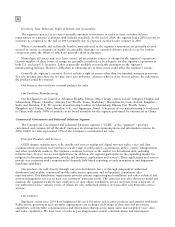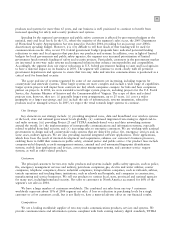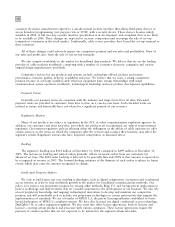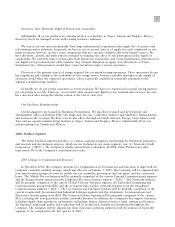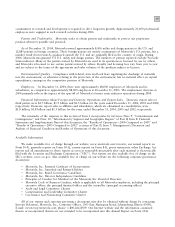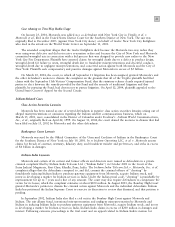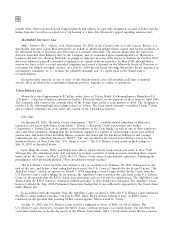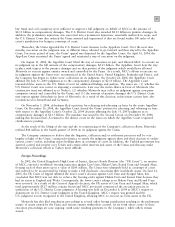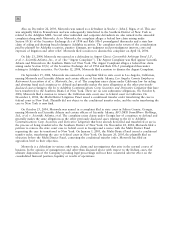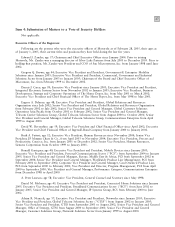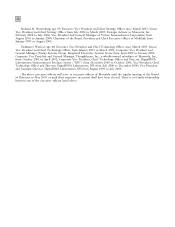Motorola 2004 Annual Report Download - page 26
Download and view the complete annual report
Please find page 26 of the 2004 Motorola annual report below. You can navigate through the pages in the report by either clicking on the pages listed below, or by using the keyword search tool below to find specific information within the annual report.
18
Other Information
Financial Information About Segments. The response to this section of Item 1 incorporates by reference
Note 10, ""Information by Segment and Geographic Region,'' of Part II, Item 8: Financial Statements and
Supplementary Data of this document.
Customers. Motorola sold approximately 10% of its products and services to Nextel and its aÇliates in 2004.
In addition to Nextel, Motorola has several other large customers, the loss of one or more of which could have a
material adverse eÅect on Motorola. Based on 2004 annual sales, in addition to Nextel, other large Motorola
customers include China Mobile, Cingular and Vodafone.
Approximately 2% of Motorola's net sales in 2004 were to various branches and agencies, including the armed
services, of the U.S. Government. All contracts with the U.S. Government are subject to cancellation at the
convenience of the Government.
Government contractors, including Motorola, are routinely subjected to numerous audits and investigations,
which may be either civil or criminal in nature. The consequences of these audits and investigations may include
administrative action to suspend business dealings with the contractor and to exclude it from receiving new
business. In addition, Motorola, like other contractors, reviews aspects of its government contracting operations,
and, where appropriate, takes corrective actions and makes voluntary disclosures to the U.S. Government. These
audits and investigations could adversely aÅect Motorola's ability to obtain new business from the
U.S. Government.
Backlog. Motorola's aggregate backlog position, including the backlog relating to other Motorola segments,
as of the end of the last two Ñscal years was approximately as follows:
December 31, 2004 ÏÏÏÏÏÏÏÏÏÏÏÏÏÏÏÏÏÏÏÏÏÏÏÏÏÏÏÏÏÏÏÏÏÏÏÏÏÏÏÏÏÏÏÏÏÏÏÏÏÏÏÏÏÏÏÏÏÏÏÏÏ $6.3 billion
December 31, 2003 ÏÏÏÏÏÏÏÏÏÏÏÏÏÏÏÏÏÏÏÏÏÏÏÏÏÏÏÏÏÏÏÏÏÏÏÏÏÏÏÏÏÏÏÏÏÏÏÏÏÏÏÏÏÏÏÏÏÏÏÏÏ $6.2 billion
Except as previously discussed in this Item 1, the orders supporting the 2004 backlog amounts shown in the
foregoing table are believed to be generally Ñrm, and approximately 92% of the backlog on hand at December 31,
2004 is expected to be shipped or earned, with respect to contracts accounted for under percentage-of-completion
of accounting, during 2005. However, this is a forward-looking estimate of the amount expected to be shipped, and
future events may cause the percentage actually shipped to change.
Generally, Motorola recognizes revenue for product sales when: (1) title transfers, (2) the risks and rewards
of ownership have been transferred to the customer, (3) the fee is Ñxed and determinable, and (4) collection of
the related receivable is probable, which is generally at the time of shipment. Accruals are established, with related
reduction to revenue, for allowances for discounts and for price protection, returns and incentive programs for
distributors and end customers related to these sales based on actual historical exposure at the time the related
reserves are recognized. For long-term contracts, Motorola uses the percentage-of-completion method to recognize
revenues and costs based on the percentage of costs incurred to date compared to the total estimated contract
costs. For contracts involving new and unproven technologies, revenues and proÑts are deferred until technological
feasibility is established, customer acceptance is obtained and other contract-speciÑc terms have been completed.
Provisions for losses are recognized during the period in which the loss Ñrst becomes apparent. Revenue for services
is recognized ratably over the contract term or as services are performed. Revenue related to licensing agreements is
recognized over the licensing period or at the time the Company has fulÑlled its obligations and the fee is Ñxed and
determinable.
Research and Development. Motorola's business segments participate in very competitive industries with
constant changes in technology. Throughout its history, Motorola has relied, and continues to rely, primarily on its
research and development (""R&D'') programs for the development of new products, and on its production
engineering capabilities for the improvement of existing products. Technical data and product application ideas are
exchanged among Motorola's business segments on a regular basis. Management believes, looking forward, that
Motorola's commitment to R&D programs, both to improve existing products and services and to develop new
products and services, together with its utilization of state-of-the-art technology, should allow each of its segments
to remain competitive.
R&D expenditures relating to new product development or product improvement were approximately
$3.1 billion in 2004, compared to $2.8 billion in both 2003 and 2002. R&D expenditures increased 9% in 2004 as
compared to 2003, after increasing 1% in 2003 as compared to 2002. Motorola continues to believe that a strong


